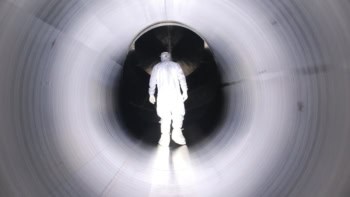An international team of physicists at CERN, the European centre for particle physics, says that it has compelling evidence for a new state of matter, a soup of free quarks and gluons. Individual experiments in CERN's lead-beam programme have produced evidence for such a soup before, but the new evidence, announced today, is more conclusive since it pulls together the results of seven different experiments. The quark-gluon state of matter is thought not to have existed since the universe was a mere one-millionth of a second old, and lends strong support to existing theories of the early universe, as well as the Standard Model of particle physics.
In the CERN experiments a 33 TeV lead ion beam was crashed into targets made of lead and gold inside the seven different experimental detectors. The collisions created energy densities twenty times that of ordinary nuclear matter in order to break down the forces that normally confine quarks within protons and neutrons. The collisions produced fewer J/psi particles and more strange particles than would otherwise be expected.
The real aim of such experiments, however, is to produce a “quark-gluon plasma”, in which the quarks and gluons exist in thermal equilibrium within the soup. The CERN researchers cannot say for sure that they have produced such a plasma since they have not managed to create a soup that exists for a long enough period of time. This requires a larger soup and therefore higher energies.
Higher energy experiments are expected to start this year at the Relatvistic Heavy Ion Collider (RHIC) at the Brookhaven National Laboratory near New York. A press release issued by Brookhaven to coincide with the CERN announcement pointed out that the European lab had not scooped their experiment, but said that “their results do generate great confidence that the quark-gluon plasma may be directly observed for the first time when RHIC achieves full operational status.” RHIC should produce one of the key signatures needed to prove the existence of a quark-gluon plasma – the spectrum of thermal photons given off in the ion collisions.
Although Brookhaven regard this signature as vital, John Kinson of Birmingham University, and one of the researchers on the WA97 experiment, sees it as detail. “It is 99% certain that a quark-gluon plasma has been produced at CERN,” says Kinson. “RHIC will dot a few i’s and cross a few t’s.” Kinson adds that the heavy ion experiments to be carried out at CERN’s Large Hadron Collider, due to come online in 2005, will produce far higher energies than RHIC and believes that this “will be the real step forward.”



